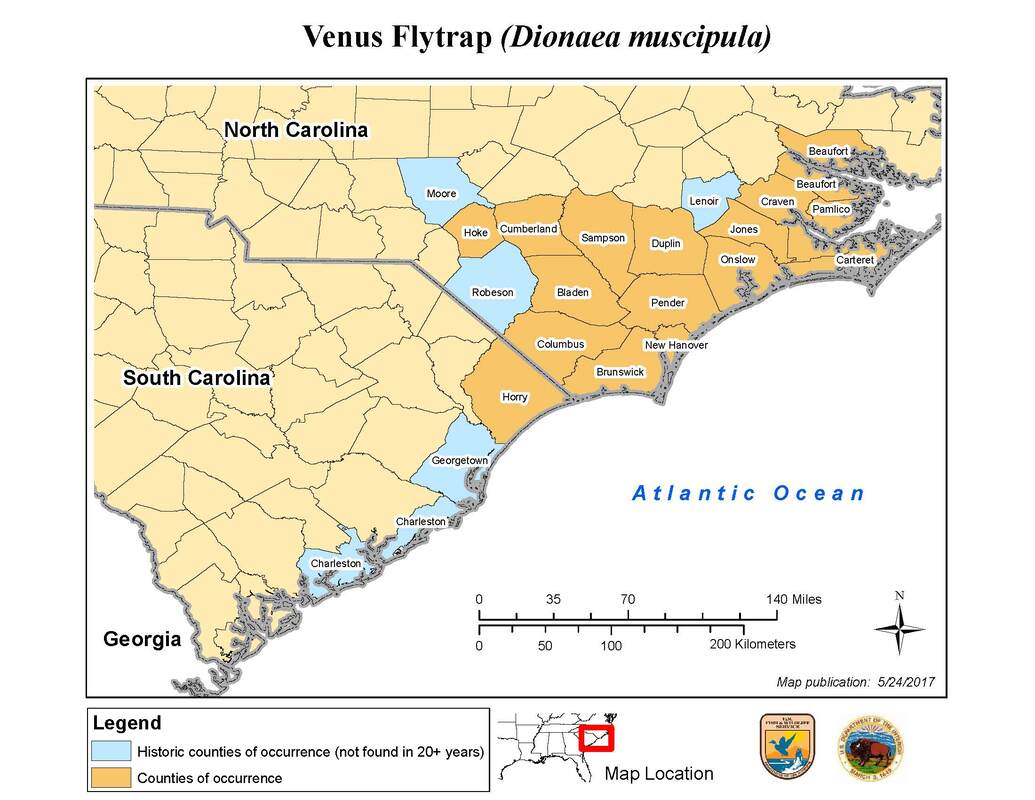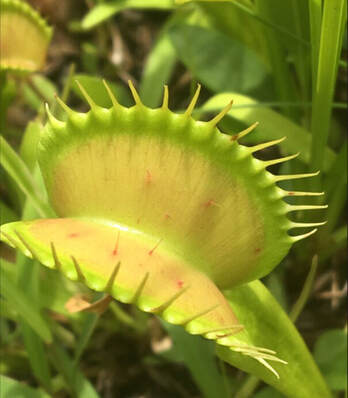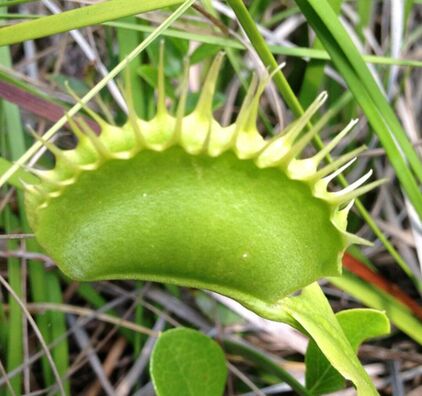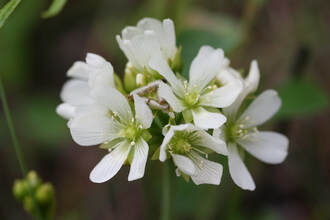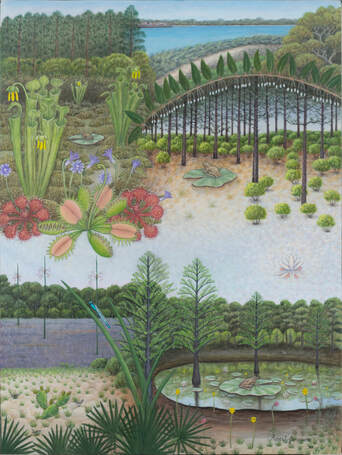About Venus Flytrap
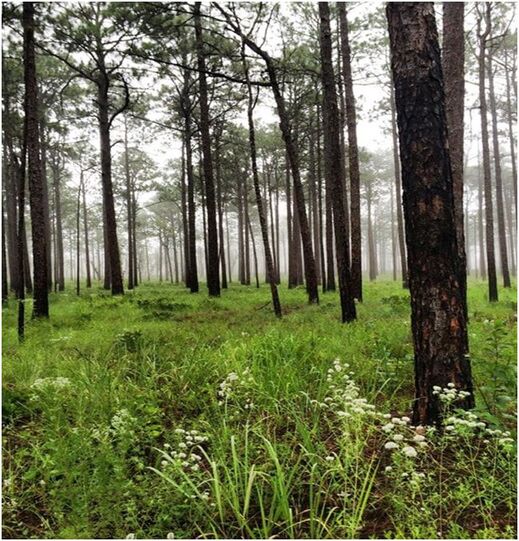 Photo by Caroline Krom.
Photo by Caroline Krom.
The Venus Flytrap is native to very specific habitats in a small area of North and South Carolina, 100 miles inland from Wilmington, NC. It grows in longleaf pine ecosystems in two regions of the Carolinas – the Coastal Plain and the Sandhills. In the Coastal Plain, where it is more common, it grows in wet pine savannas on flat sites with moist soils. It can also be found in seasonally flooded depressions and may grow along the edges of open water. In the Sandhills, Venus Flytrap is limited to narrow, moist areas along small creeks between upland longleaf forests and evergreen shrub thickets, and also in seepages within longleaf pine uplands.
Venus Flytrap Status: updated July 2023
|
|
The US Fish and Wildlife Service (USFWS) contracted with the NC Natural Heritage Program to conduct status survey in 2019 and 2020 of known populations of Venus Flytrap. Preliminary results showed decline due to land conversion and development as well as lack of burning where appropriate habitat still exists. On July 25, 2023, USFWS published their decision not to list Venus Flytrap as a threatened or endangered species.
READ the USFWS press release . . . then see box below for two responses: "The recent decision of the US Fish & Wildlife Service not to list the Venus flytrap as an endangered or threatened species does not mean that this unique species is secure and does not need our help. It actually needs even more help . . ." READ Our RESPONSE. And at The Coastal Review: "Carolina's Most Unique Plant Still in Peril" |
In accordance with the Plant Protection and Conservation Act of NC, the State of North Carolina changed its status for Venus Flytrap (from Special Concern) to Threatened. (See NC’s Protected Plant List.)
Lesley Starke, former NC Plant Conservation Program Manager, explained--
Lesley Starke, former NC Plant Conservation Program Manager, explained--
Today Venus Flytrap faces three primary threats: (1) increasing habitat loss due to residential and commercial development, (2) habitat degradation as a result of fire suppression, including direct impacts from activities such as installing firebreaks through flytrap habitat, and (3) poaching/harvesting of wild individuals. For this range-restricted species, habitat loss and degradation are key drivers to its decline, especially in the inner coastal plain where most populations have been entirely lost. Populations persisting in the outer coastal plain and Sandhills are concentrated in only a half-dozen large protected areas that are being actively managed with prescribed fire; these are the most viable populations. Poaching threats remain important, especially in protected areas where development and fire suppression threats have been addressed.
What's so special about Venus Flytrap?
The Venus Flytrap (scientific name Dionaea muscipula) is one of the most widely recognized plants on Earth due to its unique snap traps. The “trap” located at the tip of the leaf is about an inch across and consists of two hinged lobes. Each lobe has 3 to 5 hair-like projections that when tickled, cause the two lobes to snap shut, trapping insects. The trap will only snap shut if the hairs are touched 2 or more times within 20 seconds so the plant does not waste energy on false alarms (at higher temperatures, it often only takes a single touch to trip the trap). Bristles along the edge of each lobe interlock when the trap is closed so prey can’t escape.
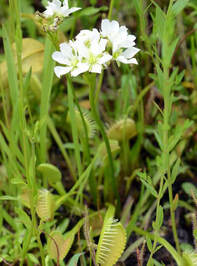 Photo by Tom Earnhardt. Photo by Tom Earnhardt.
The flowers of Venus Flytrap are white and clustered at the top of a stalk arising from the center of the leaf cluster. Each flower is about 1/2-inch across and composed of five oval, delicately veined petals. Studies show that the insects that pollinate Venus Flytrap are not generally lured into the leaf traps--a decidedly advantageous strategy. A capsule eventually forms from each flower and contains a number of shiny black seeds.
|
Why do Venus Flytraps eat insects?
Like most green plants, the Venus Flytrap’s main source of energy is from photosynthesis, but the digestion of trapped insects--beetles, spiders, ants--provides nutrients like nitrogen that are limited in the acidic, nutrient-poor, wet sandy soils where these plants grow.
What's behind that name?
The Venus Flytrap was introduced to western science in 1759 by North Carolina's Colonial Governor Arthur Dobbs, who wrote in his diary, “The greatest wonder of the vegetable kingdom is a very curious unknown species. Upon touching the leaves, they instantly close like a spring trap. It bears a white flower. To this surprising plant, I have given the name Fly Trap.”
The scientific name Dionaea refers to the Greek goddess Aphrodite and muscipula means fly or mouse trap. By the mid-1850s, Carolina’s Venus Flytrap was known worldwide.
The scientific name Dionaea refers to the Greek goddess Aphrodite and muscipula means fly or mouse trap. By the mid-1850s, Carolina’s Venus Flytrap was known worldwide.
Where to see Venus Flytrap
|
In North Carolina, you can see native populations of Venus Flytraps at Carolina Beach State Park and at The Nature Conservancy’s Green Swamp Preserve. In South Carolina, visit Lewis Ocean Bay Preserve.
Living collections of Venus Flytrap and other carnivorous plants can be seen at the Stanley Rehder Carnivorous Plant Garden* at Piney Ridge Nature Preserve in Wilmington, NC, the North Carolina Botanical Garden in Chapel Hill, and the UNC Charlotte Botanical Gardens. In South Carolina, Venus Flytraps are on display at the SC Aquarium in Charleston. *An article in Intracoastal Living Magazine (April 2021) tells the story of the Rehder brothers, founders of the carnivorous plant collection at the heart of the Stanley Rehder garden. |

